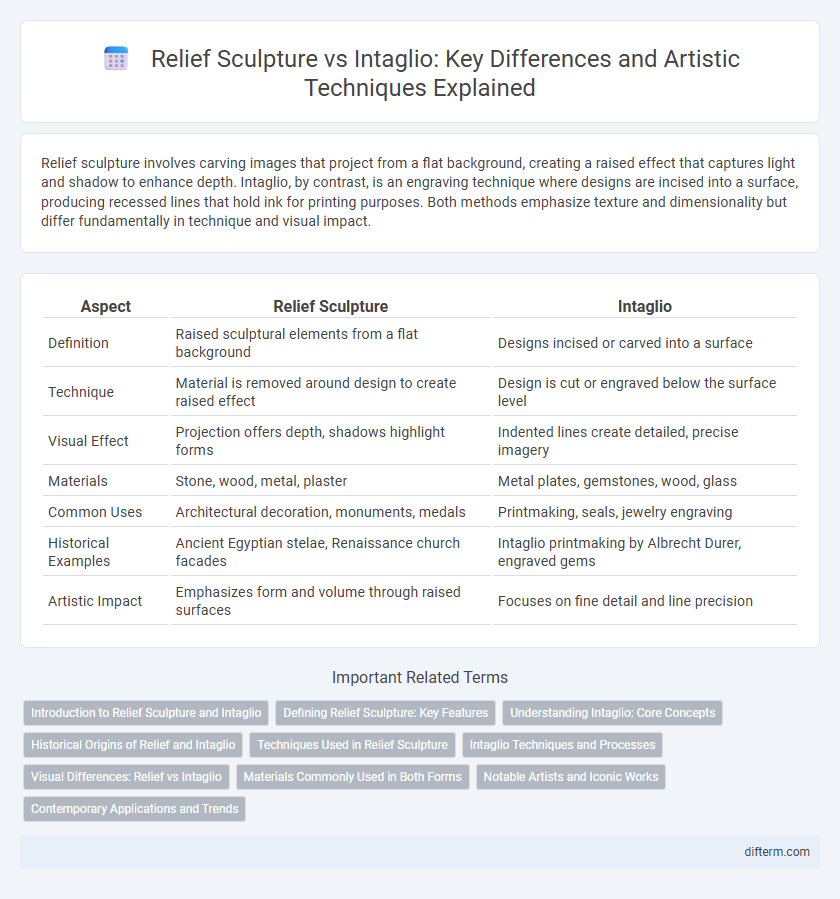Relief sculpture involves carving images that project from a flat background, creating a raised effect that captures light and shadow to enhance depth. Intaglio, by contrast, is an engraving technique where designs are incised into a surface, producing recessed lines that hold ink for printing purposes. Both methods emphasize texture and dimensionality but differ fundamentally in technique and visual impact.
Table of Comparison
| Aspect | Relief Sculpture | Intaglio |
|---|---|---|
| Definition | Raised sculptural elements from a flat background | Designs incised or carved into a surface |
| Technique | Material is removed around design to create raised effect | Design is cut or engraved below the surface level |
| Visual Effect | Projection offers depth, shadows highlight forms | Indented lines create detailed, precise imagery |
| Materials | Stone, wood, metal, plaster | Metal plates, gemstones, wood, glass |
| Common Uses | Architectural decoration, monuments, medals | Printmaking, seals, jewelry engraving |
| Historical Examples | Ancient Egyptian stelae, Renaissance church facades | Intaglio printmaking by Albrecht Durer, engraved gems |
| Artistic Impact | Emphasizes form and volume through raised surfaces | Focuses on fine detail and line precision |
Introduction to Relief Sculpture and Intaglio
Relief sculpture involves carving or modeling figures that project from a flat background, creating a raised, three-dimensional effect on surfaces such as walls or panels. Intaglio, in contrast, is a printmaking technique where designs are incised into a surface, often metal plates, and ink is applied into these recessed areas to create prints. Both methods emphasize depth and texture, with relief sculpture focusing on positive projection and intaglio on engraved recesses.
Defining Relief Sculpture: Key Features
Relief sculpture is characterized by its raised elements that project from a flat background, creating a three-dimensional effect while remaining attached to the surface. Key features include varying depths such as high relief (altorilievo) and low relief (bas-relief), which influence the perception of shadows and textures. Unlike intaglio, relief sculpture's design stands out from the substrate, enhancing visibility and tactile interaction.
Understanding Intaglio: Core Concepts
Intaglio is a printmaking technique where lines and areas are incised into a metal plate, creating recessed designs that hold ink. Unlike relief sculpture that raises the design above the background, intaglio engravings produce prints by transferring ink from these sunken grooves onto paper. Key methods within intaglio include etching, engraving, drypoint, and aquatint, each offering unique textural effects and tonal variations essential for detailed artistic expression.
Historical Origins of Relief and Intaglio
Relief sculpture originated in ancient Mesopotamia and Egypt, where artists carved raised images from stone or wood to adorn temples and monuments, serving both decorative and narrative purposes. Intaglio, on the other hand, dates back to the Bronze Age, with early examples found in Minoan and Mycenaean civilizations, involving incised designs cut into materials such as gemstones or metal for seals and jewelry. These distinct techniques reflect divergent cultural approaches to three-dimensional art and have influenced artistic traditions across Europe and the Mediterranean for millennia.
Techniques Used in Relief Sculpture
Relief sculpture techniques involve carving or modeling material so that the sculpted elements remain attached to a solid background, creating raised images that project from the surface. Common methods include bas-relief, where the depth is shallow, and high relief, where the forms are deeply carved and stand out prominently. Artists often use tools such as chisels, rasps, and modeling tools to shape materials like stone, wood, or clay, emphasizing texture and depth without fully detaching the figures from the substrate.
Intaglio Techniques and Processes
Intaglio techniques involve carving or engraving designs into a surface, typically metal plates, creating recessed areas that hold ink for printing. Processes like etching, engraving, and drypoint utilize tools or acid to incise detailed lines below the surface, producing high-precision and richly textured prints. This contrasts with relief sculpture, where the image projects outward, highlighting the intaglio method's emphasis on depth and intricate line work beneath the plate's surface.
Visual Differences: Relief vs Intaglio
Relief sculpture features raised images that project from a flat background, creating depth and allowing light to cast shadows that emphasize form and texture. Intaglio involves incising or engraving designs into a surface, producing recessed lines or grooves filled with ink for printmaking, resulting in a contrasting visual effect. The key visual difference lies in relief's protruding elements versus intaglio's sunken impressions, each offering distinct tactile and lighting dynamics.
Materials Commonly Used in Both Forms
Relief sculpture typically utilizes materials such as stone, wood, and metal to create raised images from a flat background, emphasizing texture and depth. Intaglio, on the other hand, is commonly executed on metal plates like copper or zinc, where designs are engraved or incised below the surface to hold ink for printmaking. Both forms often share materials like bronze and stone, but their methods of manipulation and surface treatment distinguish the final artistic effect.
Notable Artists and Iconic Works
Relief sculpture, exemplified by artists like Donatello with his "Saint George" and Lorenzo Ghiberti's "Gates of Paradise," showcases raised images on a flat surface, contrasted by Intaglio, which engravers like Albrecht Durer mastered through intricate prints such as "Melencolia I." Relief emphasizes form projection and tactile depth, while Intaglio relies on incised lines and detailed inking techniques to create images. These methods highlight differing artistic traditions, with relief dominating architectural and monumental art, and intaglio becoming central to printmaking and book illustration.
Contemporary Applications and Trends
Relief sculpture, characterized by raised designs on a flat background, frequently appears in contemporary public art installations and architectural facades, emphasizing tactile interaction and spatial depth. Intaglio, where designs are engraved or incised into surfaces, finds modern application in printmaking and mixed-media artworks, offering precision and intricate detail enhancement. Current trends highlight a fusion of both techniques to explore texture contrasts and dimensional interplay in contemporary art practices.
Relief Sculpture vs Intaglio Infographic

 difterm.com
difterm.com